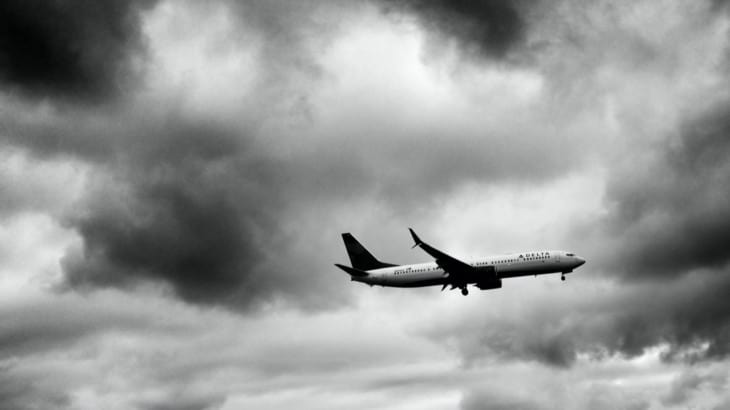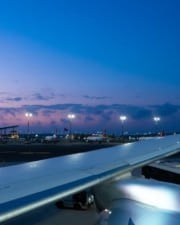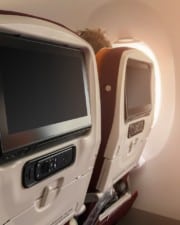When a plane starts to shake and rattle mid-flight, most passengers become understandably scared. During those stressful moments you will likely wonder if turbulence could make the plane crash. However, turbulence is a common occurrence and rarely poses a threat. The chance of bad weather or turbulence causing a plane to crash is equal to the risk posed by sabotage.
TLDR – Modern airplanes and pilot training severely reduce the risk of a plane crash due to turbulence. When dealing with moderate to extreme turbulence, pilots slow the aircraft to regain control and fly through the shaky circumstances.
Turbulence due to bad weather rarely causes modern airplanes to crash. Today’s pilots can handle most turbulence, thanks to improved aircraft designs and more knowledge of the causes of turbulence.
Different Levels and Types of Turbulence
There are multiple types of turbulence. Mechanical and mountain wave turbulence occurs due to the air circulation around various terrains, such as mountain ridges, hills, and buildings. Thermal turbulence is caused when warm air rises and a larger body of air travels downward, creating irregular air flows.
Frontal turbulence often occurs during cold fronts. As the cold air from the weather pattern reaches warm air, the two opposing air masses create friction. This is one of the most common types of turbulence experienced on commercial flights.
Commercial airline passengers may also experience clear air turbulence (CAT). CAT is caused by changes in the airflow, typically during the winter and at heights of 15,000 feet or more. The severity of the CAT is ranked from level 1 to level 4.
Level 1 CAT is light, causing minor turbulence. Passengers may notice a few bumps. During level 2 CAT, passengers may struggle to walk down the aisle. Unsecured objects may also shift or move.
Level 3 and level 4 CAT are severe and cause the aircraft to shake. In rare instances, a pilot may temporarily lose control of the plane during a level 4 CAT. Planes may also receive structural damage.
While the risk of crashing due to turbulence has decreased over time, severe weather may still contribute to accidents and fatalities. However, turbulence accidents are more common with light aircraft, such as single-engine planes.
Smaller airplanes have smaller engines, making them more susceptible to turbulence caused by severe weather. A smaller aircraft is also less likely to be equipped with weather radar systems, de-icing systems, and predictive warning systems.
Commercial airliners and air traffic controllers have the technologies needed to accurately monitor the skies for strong winds and storms. They can typically spot severe threats and adjust speeds before entering a rough patch, reducing the risk of turbulence.
What Causes Turbulence During a Flight?
Turbulence is caused by strong winds. While people associate turbulence with air travel, it occurs everywhere, including the ground. As with the flow of a large body of water, air moves in currents and eddies. The currents typically move smoothly around objects unless they are disturbed.
When the eddies are disturbed by bad weather, they break up to create many chaotic currents. The currents can create turbulence when an object crosses its path. The severity of the turbulence depends on the size of the currents and the size of the object.
For example, people walking around outside are constantly hit by air currents. To experience the effects of turbulence, a pedestrian needs to be hit by currents that are at least the size of a human.
For an airplane to experience turbulence, it needs to fly through rough patches of air containing currents that are about the size of the plane. Flying through turbulence often feels the same as driving a car over a bumpy road. The plane may also briefly feel like it is dropping.
According to one commercial airline pilot, about 80% of turbulence experienced by commercial aircraft is light. Many pilots go their entire careers without experiencing severe turbulence more than a few times.
How Many Planes Have Crashed Due to Turbulence?
Between 1980 and 2008, the Federal Aviation Administration (FAA) recorded 234 turbulence accidents. The accidents resulted in 298 injuries and three fatalities. Two of those fatalities involved passengers who were not wearing their seat belts.
Most turbulence accidents do not result in crashes or fatalities. In 2016, the FAA reported 44 injuries caused by turbulence. The following year, 21 people were injured.
In 2017, only two incidents involving severe turbulence occurred, resulting in a total of 34 injuries. No fatalities or crashes occurred during those three years.
Which Part of the Plane Is Worse for Turbulence?
Passengers sitting in the rear portion of the cabin are likely to feel the effects of turbulence more compared to those sitting further up in the cabin. The back of the plane moves more during turbulence. The tail also moves when adjusting altitude.
The smoothest part of the plane tends to be the area just in front of the wings, which is where the first-class section is typically placed. The center of gravity and lift of the plane is near the wings. This minimizes the effects of turbulence, especially on large commercial airliners.
What Are the Most Turbulent Flight Routes?
Rough air can be found in the skies above any region. However, the most common causes of turbulence include mountains, storms, and jet streams. If a route travels through one or more of those features, it is more likely to experience turbulence.
Flying from New York City to London often involves turbulence, as the direct route goes through a jet stream. However, some airlines attempt to travel around the jet stream. This increases the length of the trip but decreases the risk of turbulence.
The least turbulent routes travel over large areas of water or flat areas of land. The lack of geographical features helps create smoother air streams, reducing the risk of turbulence.
What Is the Most Dangerous Part of Flying?
Most airplane accidents occur on the runway, making takeoffs and landings the most dangerous parts of flying. When taking off or landing, the plane is close to the ground. Flying at a lower altitude gives the pilot less time to maneuver the plane to avoid an accident.
Takeoffs and landings also involve slower speeds compared to traveling in the sky, requiring the pilot to manually handle the plane. There is also less room for error on the runway, due to the presence of other planes and ground crew.
The most common cause of runway accidents is pilot error. Pilots may make a simple error of judgment due to fatigue or lack of experience. After pilots, air traffic controllers are responsible for most airplane accidents. They may make a mistake that leads to a runway incursion.
Mechanical failure is the third-leading cause of airplane accidents. A common example is the failure of the landing gear to deploy, forcing the pilot to attempt a belly landing.
About 12% of airplane accidents are reportedly due to maintenance errors. A lack of proper maintenance was also responsible for about 42% of all fatal airplane accidents between 1994 and 2004.
Bad weather is the least-common cause for airplane accidents. Climbing, descending, and cruising are the safest parts of the journey, as pilot error, air traffic controller error, and mechanical issues are most likely to occur on the ground.
Can Planes Crash Into Each Other?
Pilot error and air traffic controller errors are the leading causes of airplane accidents. However, most of these accidents occur on the runway. Most runway crashes are incursions, which occur when an aircraft is in an incorrect position.
About 12,857 runway incursions were reported between 2011 and 2016. However, most incursions do not cause crashes. Roughly 10 to 12 runway incursions result in accidents each year. Mid-air collisions are even rarer.
The most recent mid-air collision occurred on May 13, 2019. Two floatplanes collided over George Inlet in Alaska. One plane broke up in the sky, resulting in the death of the pilot and all four passengers. The other plane managed to land. However, nine passengers suffered severe injuries and one died.
The only notable mid-air collision involving a commercial airliner in recent times occurred in 2015 in Senegal. A Boeing 737 collided with an air ambulance.
The air ambulance crashed, killing all seven people on board. The 737 suffered minor damage and landed safely. None of the passengers of the 737 were injured.
Can Cell Phones Make Planes Crash?
Cell phones cannot make a plane crash. The reason that cell phones are not allowed on commercial flights is due to the potential risk of interference with ground networks used for communication between the planes and the air traffic controllers.
Cell phones and other consumer electronics are required to follow specific Federal Communications Commission (FCC) regulations. The device must accept interference from any source and may not cause harmful interference. Due to the FCC regulations, consumer electronics are unlikely to interfere with the sophisticated electronics systems found on airliners.
The Federal Aviation Administration (FAA) banned cell phones and wireless devices on airplanes in 1991. Over the next few years, the FAA and individual airlines investigated the risk of using electronic devices mid-flight. None of the research found any evidence that electronics can interfere with the safe operation of an airplane.
Related Posts













